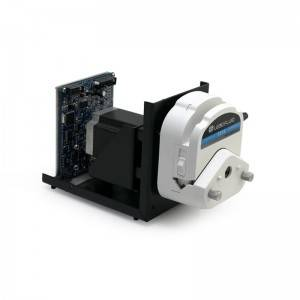The purpose of a variable speed peristaltic pump is to provide precise control over fluid transfer rates in various applications. Unlike fixed-speed peristaltic pumps, which operate at a constant speed, variable speed pumps offer the flexibility to adjust the rotational speed of the pump head. This adjustment allows for accurate regulation of flow rates, making them highly suitable for applications that require precise dosing, continuous fluid transfer, or the ability to adapt to changing process conditions.
The function of a variable speed peristaltic pump
The function of a variable speed peristaltic pump is to create a positive displacement pumping action through peristalsis. The pump consists of a pump head, tubing, and a driver mechanism. The pump head contains a rotor with rollers or shoes that compress and release the tubing in a rhythmic motion. As the rotor rotates, the rollers or shoes squeeze the tubing against the pump head, creating a positive displacement that propels the fluid forward.
By adjusting the rotational speed of the rotor, the pump can control the frequency and duration of the compression stage. This control directly affects the flow rate of the fluid being pumped. Increasing the speed results in more frequent compressions and a higher flow rate, while decreasing the speed reduces the frequency of compressions and lowers the flow rate.
The ability to vary the pump speed provides several benefits in different industries and applications:
- Precise Dosing: Variable speed peristaltic pumps are commonly used in applications where accurate dosing is critical, such as pharmaceutical manufacturing, chemical synthesis, and laboratory experiments. The adjustable speed allows for precise control over the amount of fluid dispensed, ensuring accurate and consistent dosages.
- Continuous Fluid Transfer: In processes that require a continuous flow of fluid, such as wastewater treatment, industrial mixing, or bioreactor feeding, variable speed peristaltic pumps can be adjusted to maintain a steady flow rate. This capability ensures a consistent supply of fluids and helps optimize process efficiency.
- Adaptability to Process Conditions: Some applications may require adjusting flow rates based on changing process conditions. Variable speed peristaltic pumps offer the flexibility to adapt to these variations by easily modifying the pump speed. This adaptability is particularly valuable in research and development settings where experimentation and process optimization are common.
- Gentle Pumping Action: Peristaltic pumps are known for their gentle pumping action, as the fluid only comes into contact with the tubing material. This characteristic makes variable speed peristaltic pumps suitable for handling sensitive fluids, shear-sensitive materials, and corrosive substances without compromising their integrity or causing contamination.
Overall, the purpose and function of a variable speed peristaltic pump revolve around providing precise control over fluid transfer rates. By adjusting the pump speed, users can achieve accurate dosing, maintain steady flows, adapt to changing process conditions, and handle a wide range of fluids in various industries and applications.
Here are some additional details about the purpose and function of variable speed peristaltic pumps:
- Flow Rate Control: The primary function of a variable speed peristaltic pump is to offer precise control over the flow rate of the pumped fluid. By adjusting the rotational speed of the pump head, operators can increase or decrease the flow rate according to specific requirements. This level of control allows for accurate dosing, precise mixing ratios, and the ability to match the desired flow rate for different process stages or conditions.
- Versatility: Variable speed peristaltic pumps are highly versatile and can handle a wide range of fluids, including corrosive chemicals, abrasive slurries, viscous liquids, and shear-sensitive materials. The pump’s gentle pumping action, where the fluid is enclosed in the tubing and does not come into contact with any other pump components, ensures minimal risk of contamination, chemical reactions, or damage to the fluid characteristics.
- Reversible Operation: Some variable speed peristaltic pumps have the added functionality of reversible operation. This feature allows the fluid to be pumped in both directions, enabling tasks such as fluid recirculation, backflushing, or bidirectional flow processes. Reversible operation enhances the pump’s flexibility and expands its applicability in various industries, such as analytical instrumentation or fluid circuitry systems.
- Programmable Control: Advanced variable speed peristaltic pumps may come equipped with programmable control features. These pumps allow users to define specific pumping profiles or sequences by setting parameters such as speed, acceleration, deceleration, and timing. Programmable control enhances automation capabilities, making the pumps suitable for integration into complex systems or processes where precise and synchronized fluid transfer is required.
- Maintenance and Tube Replacement: Variable speed peristaltic pumps are designed for easy maintenance and tube replacement. The tubing used in peristaltic pumps is the only component that comes into contact with the fluid, making it the primary wear part. However, replacing the tubing is a straightforward task that can be performed quickly and without requiring specialized tools or expertise. This ease of maintenance minimizes downtime and ensures efficient operation.
- Safety and Reliability: Variable speed peristaltic pumps prioritize safety and reliability. The enclosed tubing design prevents leaks, spillage, and exposure to hazardous fluids, promoting a safe working environment. The pumps are also engineered for durability, with robust construction and reliable motor systems that can handle long hours of continuous operation.
- Integration and Control Options: Variable speed peristaltic pumps can be integrated into larger systems or control networks. They can be interfaced with external devices such as sensors, controllers, or data acquisition systems for precise monitoring and control of the pumping process. Integration options allow for seamless integration into automated workflows and enable real-time adjustments based on feedback or process variables.
In summary, variable speed peristaltic pumps offer precise control over flow rates, versatility in handling various fluids, reversible operation, programmable control options, easy maintenance, and a focus on safety and reliability. Their broad range of functions and features make them a valuable asset in industries such as pharmaceuticals, biotechnology, chemical processing, food and beverage, water treatment, and research laboratories.
